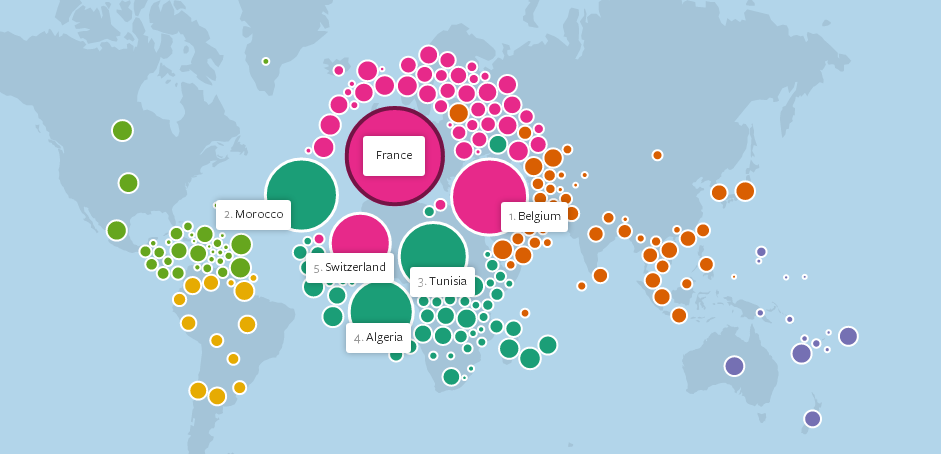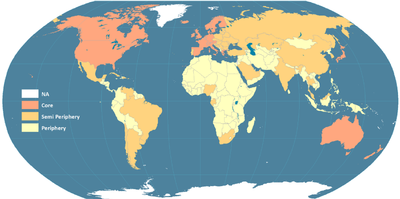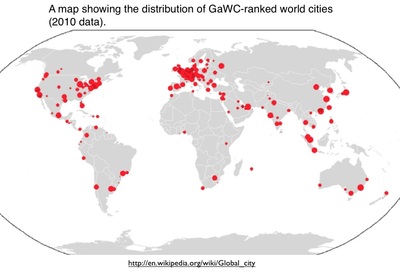Please help keep the Geographer Online a FREE resource
Measuring Global Interacations
Index
Global Participation
|
|
|
What is Globalisation
The term Globalization (or globalisation) refers to processes of international integration arising from the interchange of world views, products, ideas, and other aspects of culture. Advances in transportation and telecommunications infrastructure, including the rise of the telegraph and its posterity the Internet, are major factors in globalization, generating further interdependence of economic and cultural activities.
Though several scholars place the origins of globalization in modern times, others trace its history long before the European age of discovery and voyages to the New World. Some even trace the origins to the third millennium BCE. In the late 19th century and early 20th century, the connectedness of the world's economies and cultures grew very quickly.
The term globalization has been increasing use since the mid-1980s and especially since the mid-1990s.[6] In 2000, the International Monetary Fund (IMF) identified four basic aspects of globalization: trade and transactions, capital and investment movements, migration and movement of people and the dissemination of knowledge. Further, environmental challenges such as climate change, cross-boundary water, air pollution, and over-fishing of the ocean are linked with globalization. Globalizing processes affect and are affected by business and work organization, economics, socio-cultural resources, and the natural environment.
Adapted from Wikipedia
Though several scholars place the origins of globalization in modern times, others trace its history long before the European age of discovery and voyages to the New World. Some even trace the origins to the third millennium BCE. In the late 19th century and early 20th century, the connectedness of the world's economies and cultures grew very quickly.
The term globalization has been increasing use since the mid-1980s and especially since the mid-1990s.[6] In 2000, the International Monetary Fund (IMF) identified four basic aspects of globalization: trade and transactions, capital and investment movements, migration and movement of people and the dissemination of knowledge. Further, environmental challenges such as climate change, cross-boundary water, air pollution, and over-fishing of the ocean are linked with globalization. Globalizing processes affect and are affected by business and work organization, economics, socio-cultural resources, and the natural environment.
Adapted from Wikipedia
Key Terms
|
|
Read through the following Geofile on Globalisation and then fill in the work sheet
|
| ||||||||||||
The KOF index of Globalisation
The KOF index is a score each country is given out of 100, the higher the number the more Globalised the country is considered to be.
The KOF Index of Globalization measures the three main dimensions of globalization:
The KOF index is a score each country is given out of 100, the higher the number the more Globalised the country is considered to be.
The KOF Index of Globalization measures the three main dimensions of globalization:
- economic
- social
- and political.
- actual economic flows
- economic restrictions
- data on information flows
- data on personal contact
- and data on cultural proximity.
| 2011_kof_globalisation_index_variables.pdf | |
| File Size: | 9 kb |
| File Type: | |
| kof_index_of_globalisation.pptx | |
| File Size: | 975 kb |
| File Type: | pptx |
How useful is the KOF index?
Although the KOF index can give us an idea of overall globalization, it has got some critics, particularly about the accuracy and relevancy of the data. Criticisms include:
There is also an argument whether it is good or bad to be at the top or bottom of the globalisation list. Some people may say it is good because there is cultural diversity and that you have access to people and products from around the world. Others may argue that this is a bad thing because your culture is being lost and that your country is possibly becoming more homogenised.
Make a note of some examples of where countries are on the KOF globalization index - Chose 2 high, 2 middle and 2 low examples (give the countries their score)
Although the KOF index can give us an idea of overall globalization, it has got some critics, particularly about the accuracy and relevancy of the data. Criticisms include:
- Measures like international letters per capita are very dated. Most people now use e-mail because it is quicker and cheaper. Also trade in newspapers is slightly dated, more and more people now access there news via the internet. Again trade in books is also becoming dated as more people buy e-books or visit libraries and borrow.
- Anything to do with trade can be hard to measure because many countries do not know the true size of their informal economy (black market). Many black markets are actually involved in globalized trade e.g. human trafficking, smuggling of wild animals and drugs.
- Measuring foreign populations can be hard because of inaccurate record keeping and illegal immigrants. Countries like the US have millions of unaccounted immigrants.
- It is hard to calculate the true number of internet users. Many people don't have a home computer but access the internet at their workplace or in internet cafes.
- Some countries are small and don't have many embassies and instead rely on embassies and consulates in neighbouring countries e.g. Monaco will use embassies in France, other countries share embassies e.g. Commonwealth countries like New Zealand and Australia
- Some countries choose to stay neutral and not join international organisations e.g. Switzerland - this does not mean they are any less globalized.
- Some countries have a large number of domestic tourists, but not many international. In large countries domestic tourists can actually be very ethnically and culturally diverse, but this is not recognised. (Greenfield Geography)
There is also an argument whether it is good or bad to be at the top or bottom of the globalisation list. Some people may say it is good because there is cultural diversity and that you have access to people and products from around the world. Others may argue that this is a bad thing because your culture is being lost and that your country is possibly becoming more homogenised.
Make a note of some examples of where countries are on the KOF globalization index - Chose 2 high, 2 middle and 2 low examples (give the countries their score)
|
View the SlideShare showing the KOF index over the years and discuss the changes. |
|
|
|
Global Core and Periphery
|
Introductory discussion on Facebook and where people friend each other from. What patterns can you see?
What has happened to China? Globalisation through images. BBC Global flight paths. |
Core and Periphery
The world can be perceived as a core / periphery dichotomy where core countries are characterized by high levels of development, a capacity at innovation and a convergence of trade flows. The core has a level of dominance over the periphery which is reflected in trade and transportation. Accessibility is higher within the elements of the core than within the periphery. Most of high level economic activities and innovations are located at the core, with the periphery subjugated to those processes at various levels. This pattern was particularly prevalent during the colonial era where the development of transport systems in the developing world mainly favored the accessibility of core countries to the resources and markets of the periphery, a situation that endured until the 1960s and 1970s. The semi-periphery has a higher level of autonomy and has been the object of significant improvements in economic development (China, Brazil, Malaysia, etc.). The accessibility of the semi-periphery also improved, permitting the exploitation of its comparative advantages in labor and resources.
The world can be perceived as a core / periphery dichotomy where core countries are characterized by high levels of development, a capacity at innovation and a convergence of trade flows. The core has a level of dominance over the periphery which is reflected in trade and transportation. Accessibility is higher within the elements of the core than within the periphery. Most of high level economic activities and innovations are located at the core, with the periphery subjugated to those processes at various levels. This pattern was particularly prevalent during the colonial era where the development of transport systems in the developing world mainly favored the accessibility of core countries to the resources and markets of the periphery, a situation that endured until the 1960s and 1970s. The semi-periphery has a higher level of autonomy and has been the object of significant improvements in economic development (China, Brazil, Malaysia, etc.). The accessibility of the semi-periphery also improved, permitting the exploitation of its comparative advantages in labor and resources.
| global_core_and_periphery.pptx | |
| File Size: | 1235 kb |
| File Type: | pptx |
Print and discuss the various characteristics of the Core and Periphery. Why do the characteristics of the periphery slow down the development of these regions? Annotate your handout.
Characteristics of the Core and Periphery
|
Core
Physical Factors - Core
Human Factors -Core
|
Periphery
Physical Factors - Periphery
Human Factors - Periphery
|
Within countries sometimes urban areas develop as the core and rural areas as the periphery. Urban areas may experience urbanisation and urban growth because of rural-urban migration and rural areas may experience rural depopulation and service decline.
|
|
|













